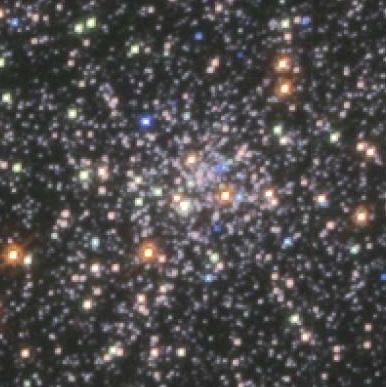Credit & Copyright: P. Guhathakurta
(UCO/Lick, UC Santa Cruz),
NASA
Explanation:
Densely packed stars in the core of the
globular cluster
M15 are shown
in this Hubble Space Telescope (HST) image.
The star colors
roughly indicate their temperatures - hot stars
appear blue, cooler stars look reddish-orange.
The region visible here is only about 1.6 light-years across,
compared to the 4.3 light-year distance to
our own Sun's nearest neighbor.
Imagine the night
sky viewed from a planet orbiting a star near this cluster's
center!
M15 has long been
recognized as one of the densest clusters of stars in our galaxy outside of
the galactic center itself.
Even the unprecedented resolving
power of the HST cameras could not separate the individual stars in its
innermost regions.
However,
this HST image reveals that the density of stars continues
to rise toward the cluster's core, suggesting that a sudden,
runaway collapse due to the gravitational attraction of many closely
packed stars or a single central massive object, perhaps a
black hole,
could account for the core's extreme density.
1999 2000 2001 2002 2003 2004 2005 2006 2007 2008 2009 2010 2011 2012 2013 2014 2015 2016 2017 2018 2019 2020 2021 2022 2023 2024 2025 |
Январь Февраль Март Апрель Май Июнь Июль Август Сентябрь Октябрь Ноябрь Декабрь |
NASA Web Site Statements, Warnings, and Disclaimers
NASA Official: Jay Norris. Specific rights apply.
A service of: LHEA at NASA / GSFC
& Michigan Tech. U.
|
Публикации с ключевыми словами:
M 15 - globular cluster - Шаровое скопление
Публикации со словами: M 15 - globular cluster - Шаровое скопление | |
См. также:
Все публикации на ту же тему >> | |
